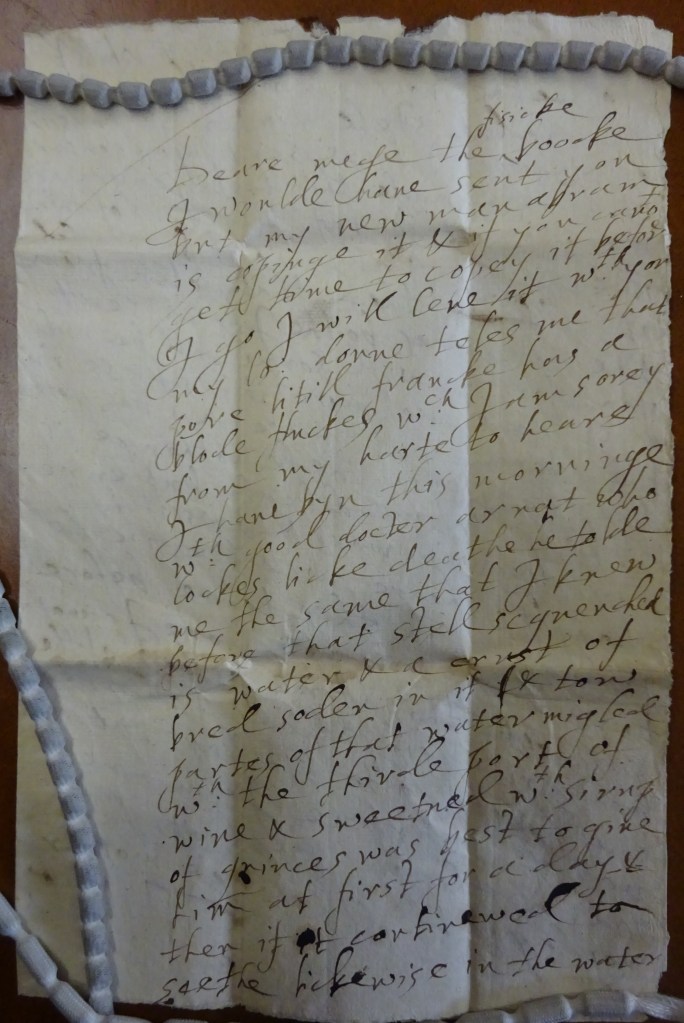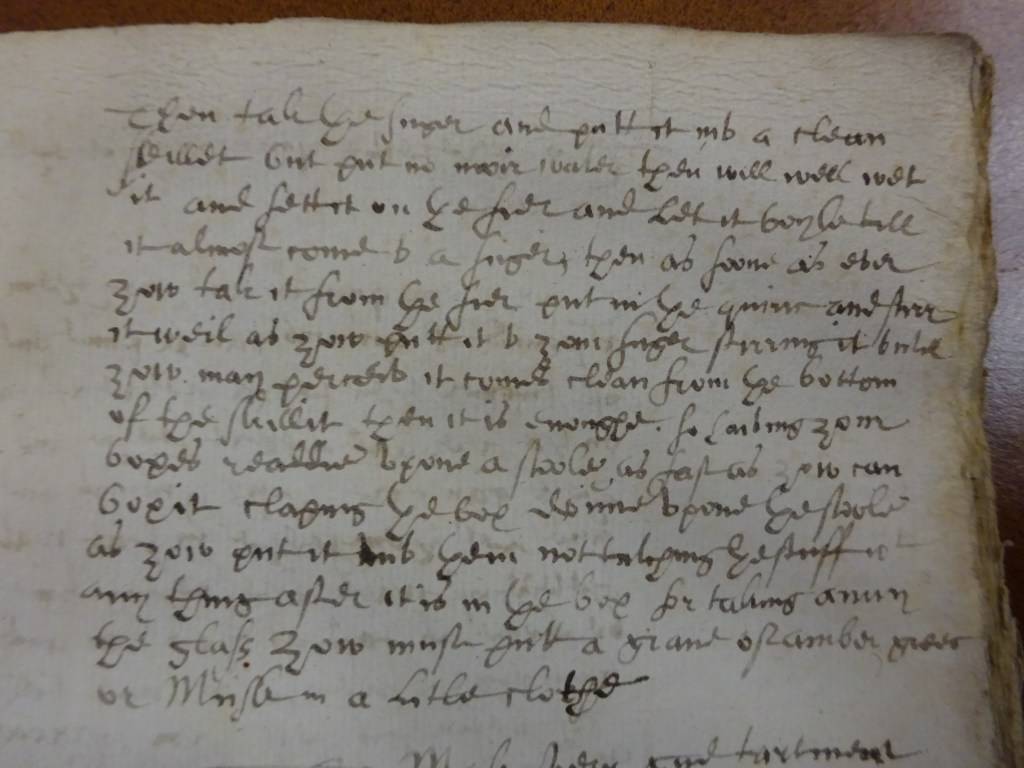
Mary Sutton Dudley, Countess of Home, wrote to her daughter, Margaret, Lady Doune, with advice about the sickness of her child Francis. She mentioned that her man Abram, probably her chaplain, Abraham Hume, was copying out a book of physic for her, and Margaret (Meg) could also copy the book. She wrote about a medical recipe involving ‘steel water’ and syrups for Francis which she had discussed with a physician in Edinburgh, David Arnot.
Three recipe books survive in the papers of the Earl of Moray, mostly written in the neat hand of a Scottish clerk, and include material in the hanwrititing of Margaret Home, later the Countess of Moray, (died 1683).
Only a small number of letters written by the Countess Home have been identified, along with the detailed annotations which she made to inventories and accounts of her estates. The inventories mention a ‘steill’, a still that she bought for distillation, this letter refers to preparing water by quenching ‘steel’ in it. This is perhaps a source of confusion to a modern reader. Moreover, one of the recipes copied, a medicine for the green sickness, includes ‘prepared powder of steel’.
‘Dear Mege, the fisick boocke I would have sent you, but my new man Abram is copinge it & if you cannot gett time to copy it before I go, I will leve it with you, My lord Doune teles me that poor little Francke has a blode fluckes which I am sorry from my heart to heare, I have byn this morning with good doctor Arnat who looks like deathe, he told me the same that I knewe before the stell squenche is water & a crust of bred soden in it & tow partes of that water migled with the third part of wine & sweetened with sirup of quinces was best to give him at first for a day & then if it continwed to seethe likewise in the water some consarve of roses but mingell the sodne stele water with consarv of bleberes I have sent you consarve of bleberries made this last yeayre in my own house but the sirup of quince is olde but allthough it bee canded it is no wors then that goten from the potecares bothe I have sent you for it will be sonne all been sold & I have no more & it is [? so base] in the toune but more ma be goten theare if you nede’

The text modernised may read; ‘Dear Meg, the physic book I would have sent you, but my new man Abraham is copying it & if you cannot get time to copy it before I go, I will leave it with you, My lord Doune tells me that poor little Frank has a bloody flux which I am sorry from my heart to hear, I have been this morning with good doctor David Arnot, who looks like death, he told me the same that I knew before; the still squench is water & a crust of bread sodden in it & two parts of that water mingled with the third part of wine & sweetened with syrup of quinces was best to give him at first for a day & then if it continued, to seethe likewise in the water, some conserve of roses but mingled the sodden ‘steel water’ with conserve of blaeberries, I have sent you conserve of blaeberries made this last year in my own house, but the syrup of quince is old but although it be candied it is no worse than that gotten from the apothecaries, both I have sent you, for it will be soon all been sold & I have no more & it is so base in the town but more may be gotten there if you need’.
Francis Stuart survived this illness. Three recipe books survive in the papers of the Earls of Moray, mostly written in a neat tiny hand, presumably Abram’s, and the characteristic hand of Margaret, Lady Doune, later Countess of Moray, and seem to be copies made as mentioned in the letter. The recipe books include medical and culinary recipes (NRAS 217, 5:15, 16, 1227).
One recipe book in pristine condition bound in vellum includes a copy of an account by Grace Fane, Countess of Home of the treatment she received from David Arnot in 1627 and 1628. She described ‘The manner of Doctor Arnott proceeded with me in meanes physicall for bringing downe my belly and restoring me to perfect healthe’. She lost her hair and died at Apethorpe in 1633. This treatment diary was copied into the vellum book by her sister-in-law, Lady Doune, who also kept letters from Grace’s mother, Mary, Countess of Westmorland (transcripts here), and a rental book of the barony of Home written by Grace in 1629.
The recipe books include remedies for the melancholy of Mary, Countess of Home, by Dr Leonard Poe, a doctor she consulted during her visits to London, a plaster involving figs which was applied to the wrists of her brother Ferdinando Dudley Sutton to treat an ague, and Doctor Gifford’s note for ‘my mother’s cough’. A course of treatment for toothache and a swollen face ‘for my lord’ by Dr Arnot probably relates to the illness of James, Earl of Home, (and his first wife, Catherine Cary) in 1622. His mother mentioned his swelling and her pulled tooth in a letter to Viscount Falkland’s agent Leonard Welstead.
Recipes for Dr Steven’s water and snail mucous for sore eyes are found in several other collections. Culinary receipts include methods for making metheglen, custard, and a variety of pies (chicken, quince, artichoke, pigeon), puddings and preserves. It is rare to find a letter describing the copying of recipes. These are the oldest Scottish recipe books known to me.
Some of the material reflects English sources, while other passages more clearly use a Scottish vocabulary, including pancakes made with ‘a mutcken of milke and aucht eggis’. A mutchkin is a quarter of a Scottish pint, a measure not used in England, and perhaps the two recipes for pancakes in a Scottish secretary hand were used at Moray House on the Canongate.
A group of recipes in Scots orthography are attributed to Mistress Young. These include marmalade and marmalade pastes made from quinces. The product was similar to the ‘cotignac’ which Mary, Queen of Scots, is documented making in France in 1551. Mary was supplied with boxes for making cotignac. Mistress Young gives methods for setting marmalade in glasses in a ‘warm cupboard’ and for transferring quince marmalade paste from a hot skillet to boxes placed on a stool.
